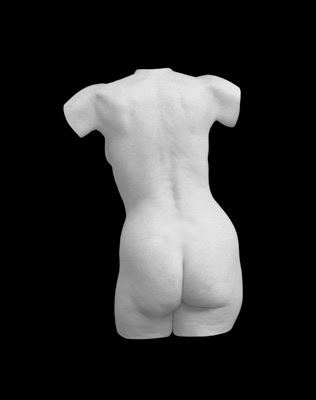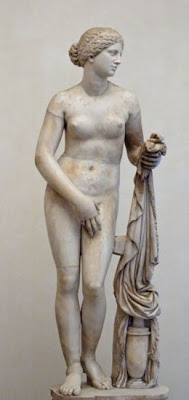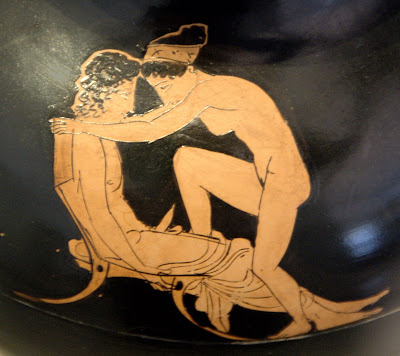 Our first model. Vessels from All Things Are Always Changing
Our first model. Vessels from All Things Are Always Changing Cnidian Aphrodite, by Praxiteles, Classical Period 330 B.C.
Cnidian Aphrodite, by Praxiteles, Classical Period 330 B.C.
Painting, Greek vessel ca. 400 B.C.
Kenneth Clark informs us that "the drift of all popular art is toward the lowest common denominator, and on the whole there are more women whose bodies look like a potato than like the Cnidian Aphrodite. The shape to which the female body tends to return is one that emphasized its biological functions; or to revive my openng metaphor, Aphrodite is always ready to relapse into her first vegetable condition....[S]he had passed from religion to entertainment, from entertainment to decoration; and then she had disappeared" by the 2nd century A.D....she had lost her meaning. (p. 93)

Albrecht Durer, nude, 1530
"When [Venus] emerged again, everything made by man had changed its shape: clothes, buildings, written characters, systems of thought and morals; and the female body had changed also, "it combines the humble body of Eve appropriate to our first unfortunate mother and the ogival rhythms of Gothic ornament".

Zeuxis Choosing Models from the Beautiful Women of Croton, FrancoisVincent, 1789
Another first, the story of the painter Zeuxis (b. 464 B.C.). Diligently he contrived to make the perfect woman, a composite Aphrodite (5 body characteristics = 1 venus). Albrecht Durer claimed to have studied 2,000 to 3,000 bodies to get it right.

from Love and Desire by Willliam A. Ewing
Venus de Milo (late 2nd century B.C) is our generations most popular Venus. Considering her placement in the Louvre, is her preeminence about visibility and marketing?
In 1821 Quatremere de Quincy, French antiquities advocate and administrator, assumed Venus de Milo was the depiction of the goddess of tender feelings overcoming the bloodlust of battle, a personification of peace after war.
Marqis de Riviere thought Venus di Milo was a realistic representation of Phrynea, mistress of Praxiteles. It was clear to him that the Cnidus Venus was the idealized version of this same woman. Regardless, everyone speculated on what she was holding.
How does Marilyn Monroe compare as another candidate for this generation's first Venus. What is the role of mystery and the imagination in this quest?

No comments:
Post a Comment